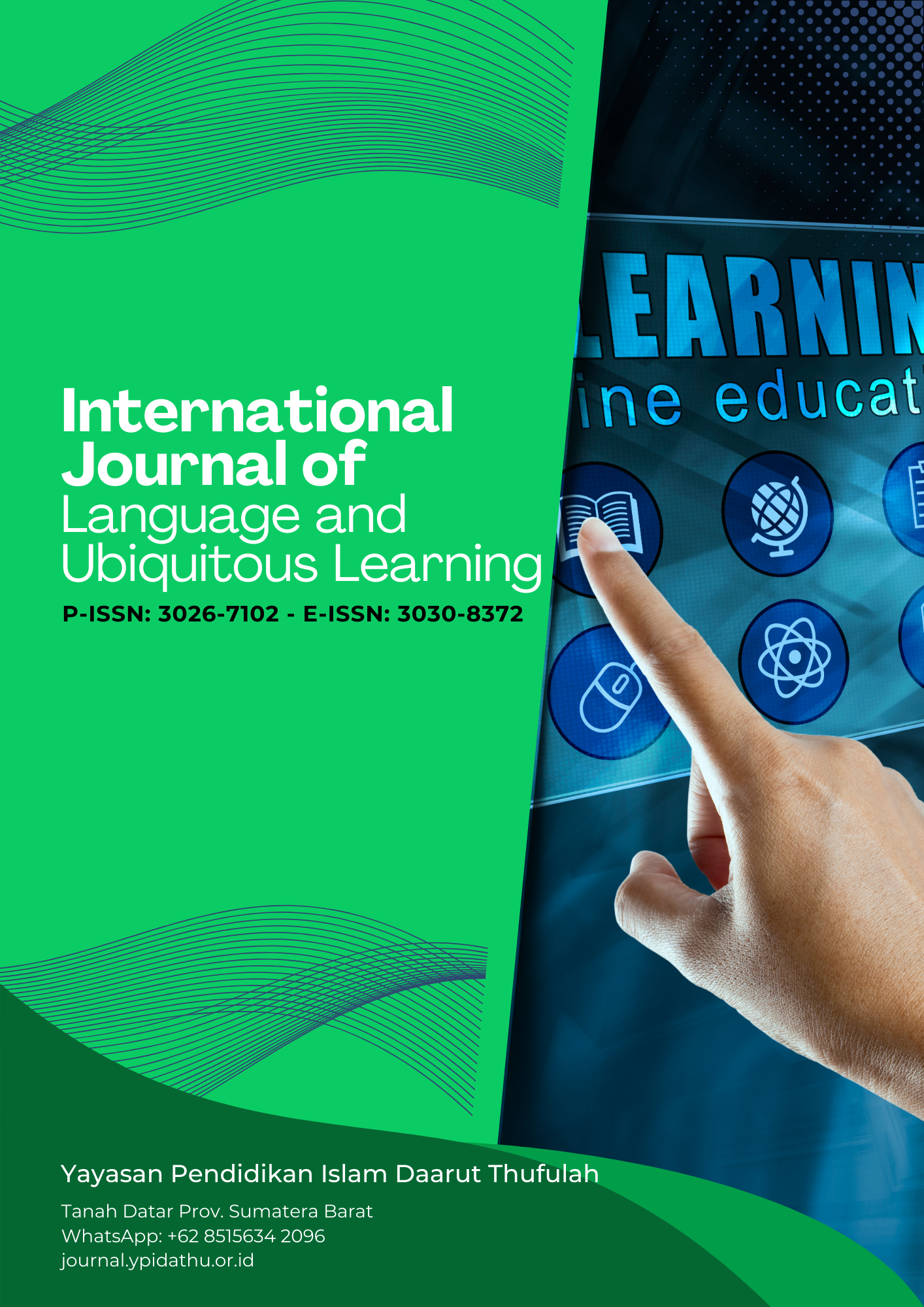Does Slang Threaten the Structure of the Mother Tongue? An Analysis of Generative Grammar in Indonesian Adolescent Language
Abstract
Background. Language is a dynamic and adaptive system that evolves in response to its users’ needs. Among Indonesian adolescents, the rise of slang has raised public concern regarding its potential to disrupt the structural integrity of the Indonesian mother tongue. This concern stems from fears that informal variations may erode grammatical norms and weaken formal language proficiency.
Purpose. This study aims to determine whether the use of slang among teenagers represents a threat to the syntactic norms of formal Indonesian or constitutes a natural form of linguistic variation that aligns with social and cognitive development.
Method. A qualitative descriptive method was employed, focusing on data collected from popular social media platforms such as TikTok, Instagram, and Twitter. Purposive sampling was used to identify common slang expressions. The data were then analyzed using the frameworks of generative grammar and psycholinguistics to explore structural changes and their cognitive implications.
Results. Analysis of three representative slang-based sentences revealed that while slang tends to omit formal elements and compress sentence structures, essential syntactic patterns—especially the subject-verb-object (SVO) sequence—remain intact. From a psycholinguistic perspective, adolescents show cognitive flexibility in both producing and interpreting these expressions contextually, rather than relying strictly on formal rules.
Conclusion. The study concludes that adolescent slang does not undermine linguistic competence. Instead, it enriches expressive ability and serves as a marker of social identity. Slang is best understood as an adaptive form of linguistic creativity shaped by digital culture and generational shifts, rather than a degradation of language.
Full text article
References
Besier, D. (2023). Grammar Competition in Second Language Acquisition: The Case of English Non-Verbal Predicates for Indonesian L1 Speakers. books.google.com. https://books.google.com/books?hl=en&lr=&id=zfSrEAAAQBAJ&oi=fnd&pg=PT8&dq=generative+grammar+indonesian+adolescents+language+variation+slang+syntactic+structure&ots=KDxwLIsj8a&sig=_LoZkmtyTd36JtPTsznmBzVMO48
COHN, A., VOGEL, R., & ABTAHIAN, M. (2022). Patterns of variation in jakarta indonesian: Linguistic and social dimensions. Query date: 2025-07-17 17:35:25. https://tufs.repo.nii.ac.jp/record/1456/files/Cohn_et.al.pdf
Gil, D. (2020). Chapter 1. What does it mean to be an isolating language? The case of Riau Indonesian. Austronesian undressed: How and why languages …, Query date: 2025-07-17 17:35:25. https://doi.org/10.1075/tsl.129.01gil
Indiani, E., Nasution, F., Azzahra, M., & ... (2024). Transfiguration of Characteristics Medan People Slang Into Formal Vocabulary of Bahasa Indonesia. Jurnal Ilmiah Wahana …, Query date: 2025-07-17 17:35:25. http://jurnal.peneliti.net/index.php/JIWP/article/view/8355
Kiaer, J. (2023). The Future of Syntax. torrossa.com. https://www.torrossa.com/gs/resourceProxy?an=5605829&publisher=FZ0661
Manurung, J., Napitupulu, M., & ... (2022). Exploring the Impact of Slang Usage Among Students on WhatsApp: A Dig-ital Linguistic Analysis. Jurnal Ilmu Pendidikan …, Query date: 2025-07-17 17:35:25. https://journals.ristek.or.id/index.php/jiph/article/view/21
Masykar, T., Nurrahmi, F., & Masykar, T. (2023). Systemic Functional Linguistics to Preserve Interpersonal and Ideational Meaning in English-Indonesian Translation. Journal of Eng-lish Education …, Query date: 2025-07-17 17:35:25. https://www.academia.edu/download/112063844/12974.pdf
Muhammad, S. (2025). The Role of Social Media in the Development of Indonesian Language Among Teenagers. Journal of Educational Analytics, Query date: 2025-07-17 17:35:25. http://nblformosapublisher.org/index.php/jeda/article/view/12
Ndlovu, S. (2022). Partial homophony and decoy lexicalisation in S’ncamtho and Ndebele slang. Southern African Linguistics and Applied Language …, Query date: 2025-07-17 17:35:25. https://doi.org/10.2989/16073614.2022.2034508
Rahayu, S. (2024). GRAMMATICAL AND LEXICAL IN INFORMAL CONVERSATION OF TEENAGER IN SUKABUMI CITY ON SUNDANESSE MAINTENANCE. Paradigma Mandiri: Jurnal Pengabdian Kepada …, Query date: 2025-07-17 17:35:25.
Rahmadani, A. (2023). Navigating multiple languages: The use and effect of code-switching in children from mixed marriage families. Indonesian Journal of Applied Linguistics, Query date: 2025-07-17 17:35:25. https://ejournal.upi.edu/index.php/IJAL/article/view/58252/0
Saputra, D., Damayanti, V., Mulyati, Y., & Rahmat, W. (2023). Expressions of the use of slang among millennial youth on social media and its impact of the extension of Indonesia in society. BAHASTRA, Query date: 2025-07-17 17:35:25. https://journal1.uad.ac.id/index.php/BAHASTRA/article/view/325
Siregar, I., & Yahaya, S. (2023). Morphological Elements of the Betawi Teenagers. Formosa Journal of Sustainable Research, Query date: 2025-07-17 17:35:25. https://www.academia.edu/download/109444897/3961.pdf
Sokolovskaya, V., & Perdana, N. (2025). … AND INDONESIAN (BAHASA) LANGUAGES: ANALYSIS OF THE INFLUENCE OF ENGLISH ON THE PHONETIC, GRAMMATICAL AND LEXICAL LEVELS …. ??? ?????, ???????? …, Query date: 2025-07-17 17:35:25. https://cyberleninka.ru/article/n/english-and-indonesian-bahasa-languages-analysis-of-the-influence-of-english-on-the-phonetic-grammatical-and-lexical-levels-of
Suhardianto, S. (2019). Colloquail, slang and transformational language: Comperative study. Jurnal Basis, Query date: 2025-07-17 17:35:25. http://ejournal.upbatam.ac.id/index.php/basis/article/view/1059
Surana, S. (2021). Sociocultural Aspects of Transgender Slang. IJOLTL (Indonesian Journal of Language Teaching …, Query date: 2025-07-17 17:35:25. https://ijotl-tl.soloclcs.org/index.php/ijoltl/article/view/680
Tompunu, N., & Hula, I. (2022a). Eloquence. Query date: 2025-07-17 17:35:25. https://www.academia.edu/download/117054569/99.pdf
Tompunu, N., & Hula, I. (2022b). Use of Indonesian Slang and Equivalents In the Arabic Language. …?: Journal of Foreign Language, Query date: 2025-07-17 17:35:25. https://ejournal.iaingorontalo.ac.id/index.php/ELOQUENCE/article/download/147/99
Zen, E. (2020). Cross-linguistic influence in third language acquisition by multilingual children in Indonesia. search.proquest.com. https://search.proquest.com/openview/e4b8486b9dcbf42e96b226e34c715174/1?pq-origsite=gscholar&cbl=2026366&diss=y
Admin Logos Indonesia. (2023). Noam Chomsky dan Teori Tata Bahasa Generatif Tranformasional . LOGOS INDONESIA.
Ahmad Sirulhaq, Sukri Sukri, Syamsinas Jafar, Syamsinas Jafar. (2022). Potential Words in Indonesian Language: A Study of Generative Morphology. Lingua Cultura, 231-240.
Alinsyah Aurorathursina. (2024). Slang Bahasa yang Sering Digunakan pada Remaja. Kompasiana.
Euis Siti Setiasih Widuriani. (2007). KARAKTERISTIK RAGAM BAHASA GAUL DI KALANGAN REMAJA : Studi tentang perubahan morfologis, fonologis, dan kosakata bahasa gaul dari tahun 1980-an sampai deugan 2000-an). UPI REPOSITORY.
Joko Suleman, Eva Putri Nurul Islamiyah. (2018). DAMPAK PENGGUNAAN BAHASA GAUL DI KALANGAN REMAJA. Prosiding SENASBASA (Seminar Nasional Bahasa dan Sastra) , 153-158.
Sugiono. (2008). Metode Penelitian Pendidikan. Bandung: Alfabeta.
Zulkhaeriyah, Dede Rosyadi ZA, Tri Pujiati. (2023). The Impact of Slang Language Used By “Gen Z” On The Existence of Indonesian Language. ELS Journal on Interdisciplinary Studies in Humanities.
Authors
Copyright (c) 2025 Vanya Rachelia Putri

This work is licensed under a Creative Commons Attribution-ShareAlike 4.0 International License.





